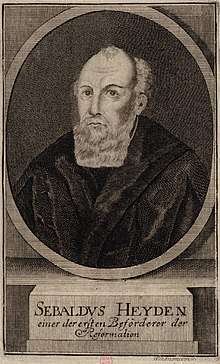Sebald Heyden
Sebald Heyden (18 December 1499 – 9 July 1561)[lower-alpha 1] was a German musicologist, cantor, theologian, hymn-writer and religious poet. He is perhaps best known for his De arte canendi ("On the Art of Singing", third installment published 1540) which is considered to have had a major impact on scholarship and the teaching of singing to young boys.[2] It has been speculated that Heyden was the world's first true musicologist.[3]

Biography
Heyden was born in Bruck (now part of Erlangen) to a family of Nuremberg patricians.[3] He studied under music theorist Johannes Cochlaeus at the school of St. Lorenz from 1505.[4] He entered the University of Ingolstadt in 1513, graduating with a master's degree in 1519.[3][4] From 1519 he worked as a cantor, and later as rector at the Nuremberg Hospital School. In January 1525 he was appointed the first Lutheran rector of the school of St. Sebald.[5] Among his pupils was Nicholas Selnecker. He was in regular contact with Hans Sachs and Albrecht Dürer. Over the decades, Heyden developed a great reputation as a scholar, devoted to studies and writing on education, theology, and music.[3] He was originally a Lutheran, but in the 1530s he became influenced by Zwingli.[3]
Heyden's first publications appeared around 1523–25, theological tracts such as Salve regina, which he gave to the Reichstag in a different Christian context.[4] In 1524 he published Adversus Hypocritas Calumniatores, super falso sibi inustam haereseos nota, also a theological tract.[6] In 1527 he began publishing textbooks such as Formulae puerilium colloquiorum (Nomenclatura).[5] His Formulae immediately became an important work, used as a phrase book between German-, Polish-, and Hungarian-speaking students at the University of Krakow.[5] In 1530, he wrote the hymn "O Mensch, bewein dein Sünde groß" (O man, bewail thy sins great). The Passion song reflects poetically in "great passion" the sufferings of Christ. He wrote it on a tune by Matthias Greitter, to the original text: "Es sind doch selig alle, die im rechten Glauben wandeln hie" (Blessed are they all who walk here in true faith). In 1532 he published further text books Leges scholasticae and Musicae stoicheiosis.
Heyden's De arte canendi, its third and final edition completed in Nuremberg in 1540, is said to have "had a greater impact on modern scholarship than any other writing on mensuration and tactus from the 15th or 16th century."[3] A collection of secular songs, it has been described as a "treatise on singing technique aimed at the growing number of amateur musicians who wished to improve their skills."[7] The first installment was produced in 1532 in 26 pages, the second in 1537 grew to 115 pages and the third in 1540 to 163 pages.[4] From 1537, Heyden borrowed a copy of Tinctoris's Proportionale from Georg Forster and extensively studied the composers featured in it.[4] Heyden also composed several hymns and poems.[8] In the third installment, Heyden confessed to being an admirer of Josquin des Prez and his contemporaries, transcribing Josquin's Missa L'homme armé sexti toni (Benedictus), amongst others.[9][10] Notably, Heyden is said to have "adopted a horror fusae position at a time when Italian musicians were writing pieces a note nere under the signature of C."[9] Indeed, the treatise is said to have "influenced many twentieth-century scholars to believe that the tactus of the sixteenth century represented an unvarying beat."[11] In 1546 he published Paedonomia scholastica pietatis, studii literarij ac morum.[12]
Heyden died in Nuremberg.
Notes
- His birth year may also be 1498, 1494, or 1488.[1]
References
- Eitner, Robert (1880), "Heyden, Sebald", Allgemeine Deutsche Biographie (ADB) (in German), 12, Leipzig: Duncker & Humblot, pp. 352–353
- Schiltz, Katelijne; Blackburn, Bonnie J. (2007). Canons and canonic techniques, 14th-16th centuries: theory, practice, and reception history. Peeters Publishers. p. 304. ISBN 978-90-429-1681-4. Retrieved 4 April 2012.
- DeFord, Ruth I. "Sebald Heyden (1499–1561): The first historical musicologist?" (PDF). Hunter College and The Graduate Center of The City University of New York. Archived from the original (PDF) on 15 April 2012. Retrieved 4 April 2012.
- Judd, Cristle Collins (2 November 2006). Reading Renaissance Music Theory: Hearing with the Eyes. Cambridge University Press. p. 91-. ISBN 978-0-521-02819-6. Retrieved 4 April 2012.
- Macardle, Peter (1 December 2007). Confabulations: Cologne life and humanism in Hermann Schotten's Confabulations tironum litterariorum (Cologne, 1525). Durham Modern Languages. p. 124. ISBN 978-0-907310-67-9. Retrieved 4 April 2012.
- Heyden, Sebald (1524). Adversus Hypocritas Calumniatores, super falso sibi inustam haereseos nota[m], de inversa cantilena, quae Salve regina incipit, Sebaldi Heiden defensio. Petreius. Retrieved 4 April 2012.
- International Association of Music Libraries. United Kingdom Branch (2005). Brio. The Branch. pp. 10–15. Retrieved 4 April 2012.
- Williams, David Russell; Balensuela, C. Matthew (2007). Music theory from Boethius to Zarlino: a bibliography and guide. Pendragon Press. p. 106. ISBN 978-1-57647-157-9. Retrieved 4 April 2012.
- Haar, James; Corneilson, Paul Edward (24 August 1998). The Science and Art of Renaissance music. Princeton University Press. p. 178. ISBN 978-0-691-02874-3. Retrieved 4 April 2012.
- Smith, Anne (30 March 2011). The Performance of 16th-Century Music: Learning from the Theorists. Oxford University Press. p. 29. ISBN 978-0-19-974262-2. Retrieved 4 April 2012.
- Houle, George (June 2000). Meter in music, 1600-1800: performance, perception, and notation. Indiana University Press. p. 3. ISBN 978-0-253-21391-4. Retrieved 4 April 2012.
- Heyden, Sebald (1546). Paedonomia scholastica pietatis, studii literarij ac morum honestatis precepta continens. Montanus. Retrieved 4 April 2012.
External links
| Wikimedia Commons has media related to Sebald Heyden. |
- Literature by and about Sebald Heyden in the German National Library catalogue
- Sebaldus Heyden - Formulae puerilium colloquiorum Bibliotheca Latina